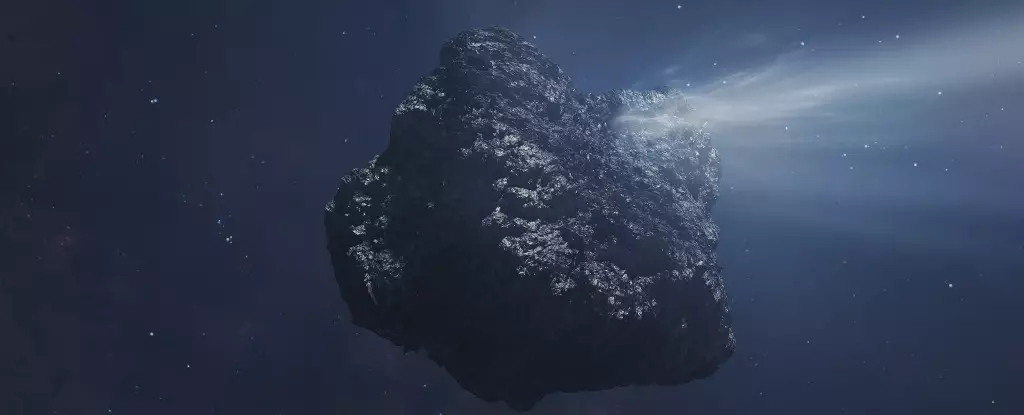Many people find solace in the predictability of our universe, but the impending arrival of Comet C/2014 UN271 (Bernardinelli-Bernstein) serves as a stark reminder of the cosmos’ unpredictability and awe. As it hurtles toward the inner Solar System, this colossal harbinger from the Oort Cloud mirrors our fascination with the unknown, illustrating the sheer scale of existence beyond our blue planet. Spanning an astonishing 137 kilometers (85 miles) in diameter, UN271 is not only the largest comet observed but also embodies the terrifying scale of cosmic events beyond human comprehension. This gargantuan object is almost 14 times larger than the asteroid that led to the extinction of the dinosaurs, raising the eyebrows of both scientists and laypeople alike.
The fearful thrill this comet brings is twofold. On one hand, its colossal size evokes a sense of impending doom reminiscent of disaster movies, sending shivers down the spine of even the most stalwart of skeptics. On the other, it serves as a reminder of humanity’s precarious position in the cosmos, both insignificantly small and magnificently curious. However, there is a silver lining: UN271 is projected to remain safely outside the orbit of Saturn at its closest approach on January 29, 2031, and that gives us a momentary reprieve from outright panic.
A Cosmic Laboratory in Action
The comet’s recent outbursts have captured the attention of astronomers around the world. Observations utilizing the Atacama Large Millimeter/submillimeter Array (ALMA) in Chile revealed intriguing molecular activities. This cosmic laboratory offers us insights into not just what UN271 is but also how comets evolve as they journey through the Solar System. Nathan Roth from American University and NASA’s Goddard Space Flight Center astutely claimed, “These measurements give us a look at how this enormous, icy world works.” Such scientific endeavors grant us a brief glimpse into the workings of the universe, showcasing humanity’s unceasing quest for knowledge, even amid existential fears.
ALMA’s observations on March 8 and 17, 2024, depicted a comet in flux, releasing jets of carbon monoxide and subsequently forming the beginnings of a coma. Herein lies the beauty of astrophysics: in a world that thrives on rapid change and chaos, scientists can use celestial events like this to further understand fundamental questions about our own existence. The first jet emitted by UN271 represented an astonishing moment of discovery, opening a window to the unpredictable nature of cosmic evolution. Yet, by March 17, the evidence of the earlier jet had significantly diminished, leaving us to wonder if this comet is a harbinger of instability, not only in its direction but in our understanding of cometary behavior.
The Unseen Dangers of Cosmic Entities
While UN271 is certainly captivating, it’s essential to confront the hidden dangers represented by such massive celestial bodies. The specter of cosmic forces should not be brushed aside or romanticized; instead, they warrant rigorous examination and discourse. The reality remains that the universe is full of disruptions that could dramatically affect our planet. A comet of this size, had it veered onto a collision course, could have catastrophic ramifications, reaffirming the necessity for continued investment in planetary defense initiatives.
Furthermore, this raises critical questions about our preparedness for potential cosmic threats. Are we truly equipped to deflect a giant comet should the need arise? The advancements in space observation technology offer hope, but the unpredictability of such celestial events reveals a chink in our armor of knowledge. The actions we take today in comprehensively studying Comet UN271 could yield benefits beyond mere observation; they might inform how we respond to future threats from the cosmos.
Moreover, consider the broader implications of astronomical phenomena on societal structures. As the comet approaches, will it serve as a unifying force, motivating collaborative efforts among nations to study and understand these objects? Or will it fan the flames of fear, leading to anxiety about our future in an unfathomable universe? It’s an interesting sociopolitical crossroads at which we find ourselves.
In embracing the enigmatic characteristics of Comet C/2014 UN271, we must straddle the line between awe and vigilance, keeping one eye on the skies while remaining grounded here on Earth. The balance between wonder and caution can lead to transformative knowledge, fostering a liberal viewpoint where inquiry and preparedness coexist, igniting pathways to understanding not just our celestial neighbors, but our own place in this vast universe.

Leave a Reply